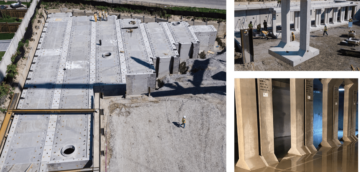The South Branch of the Greater Sudbury Public Library closed abruptly on a Friday afternoon in March 2009 due to drainage system structural concerns as a result of settlement of the foundation. A librarian turned people away at the entrance. “How long will you be closed?” the people asked. “Forever,” said the librarian. Then she locked the door. The library was built in late 1988 to early 1989. One year after the South Branch’s sudden closing, the 20-year old library building was demolished. It was gone in one day and all the rubble was carted away. A new library will be built at a cost to the City of Greater Sudbury of $4.8 million.
After the library was closed, the city hired experts who determined the cause and extent of the building’s structural damage. Geotechnical Investigation by a Consulting Geotechnical Engineer dated June 2, 2009 offered the following explanations. “A monitoring program was initiated to measure the apparent building settlements … The surveying results indicated that the current building had undergone a differential settlement in the range of 380mm between the opposite ends of the building (downward movement measured at the north west corner). The measurement suggests that the existing building had experienced some recent accelerated settlement. Evidence of this movement was apparent by walking on the main floor of the Public Library and as noted by staff.”
The report went on to conclude:
Most Probable Recent Cause of Settlement:
An inspection video obtained by the Ontario Concrete Pipe Association under The Freedom of Information and Protection of Privacy Act clearly shows holes in sections of the wall of the corrugated steel pipe storm sewer due to rusting.
Engineers responsible for designing, constructing, and inspecting drainage systems in accordance with the Ontario Building Code (OBC) should be aware that the OBC contains requirements for leakage testing of pipes used in a drainage system.
Section 7.3.6.2. Tests of Pipes in Drainage Systems states: “Every pipe in a drainage system, except an external leader or fixture outlet pipe, shall be capable of withstanding without leakage a water test, air test and final test.”
Section 7.3.6.4. Water Tests in Drain, Waste and Vent Systems states: “Where a water test is made, all joints shall be tested with a water column of not less than 3 m…the system or the section shall be kept filled with water for 15 min.”
Reinforced concrete pipe (RCP) and manholes produced in Ontario are tested in the concrete pipe plants to ensure that they meet the requirements of CSA A 257 Series, Standards for Circular Concrete Pipe and Manholes and the Ontario Building Code. The hydrostatic performance of RCP is verified by tests done at the manufacturing plant according to the Plant Prequalification Program (PPP). The PPP ensures RCP will meet the hydrostatic requirements specified in CSA A257.2 for concrete pipe with rubber gasket joints. Certification under the PPP then provides the engineer the assurance that a quality, watertight and certified pipe product is on site.
The $4.8 million rebuilding plan will see the new library financed by a combination of borrowing and contributions from reserve and capital funds. With only $1.3 million available from dedicated reserves, about $3.5 million will come from debt financing, with the city borrowing from itself and repaying the money – with interest – over more than 20 years.
Debt repayments will amount to $278,000 annually, with those funds coming from three sources: $112,000 from the existing operating budget, $110,000 in revenue from development charges and a $56,000 increase in property taxes.
Do it right the first time.

On January 21st and 22nd, Coldstream Concrete Ltd. supplied an eight-piece custom precast concrete pump ...

The Greater Toronto Area (GTA), which includes the City of Toronto, Regions of Peel, Halton, ...

IntroductionPrecast concrete has been widely used in constructing infrastructure for decades. Its ability to accelerate ...
